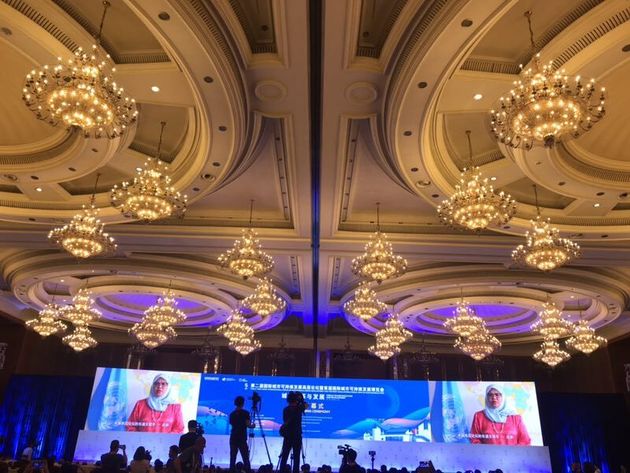
Photo/Sun Yuting
Aug. 2 (NBD) -- If a nation wants to be economically successful with urbanization as a driver for national prosperity, it has to deal with key issues including housing, pollution and lack of public spaces close to home, said an senior human settlements officer with UN Habitat.
To address issues facing China's urbanization process and to seek for new ideas and innovative solutions, the 2nd High-level International Forum on Sustainable Urban Development kicked off on Wednesday (August 1) in southwest China's Chengdu. Focusing on Urban Transformation and Development, the forum welcomed over 500 leaders and representatives from governments, cities, NGOs, institutes and private sector companies who gathered together to exchange and share insights on urbanization.
"We pretty much appreciate that Chengdu hosts this kind of event, because we (UN Habitat) are also looking around for new ideas, for exposure, for solutions for the world," the UN Habitat officer said to NBD.

Margit Noll, Chair of Joint Programming Initiative Urban Europe (Photo/Sun Yuting)
City planning, an on-going learning process
Taking regular meetings and gatherings of cities held by UN Habitat for example, the officer underscored the importance of cities getting together as well as city planning, saying that great cities are always planning while implementing existing plans.
To dig deeper into city planning, NBD had an interview with Margit Noll, Chair of Joint Programming Initiative Urban Europe, on the sidelines of the forum. Noll's programme offers forums, seminars, workshops for cities to share experiences, with the aim to address the global urban challenges and drive sustainable urban development.
Noll held that city planning is not only a matter of city government, but civil society, citizens and businesses are also part of that. It's important to have all stakeholders involved in the urban planning, and in this way, the planning and implementation can get done in cooperation with all the partners, Noll added.
Using public transportation promotion in Europe as an example, Noll demonstrated how the planning process should be and gave suggestions, "to encourage people to use more public transportation takes a lot of promotion, information and joint efforts to involve them in the planning." It's important for city planners to know the main roads and people's transportation frequency, requirements and mobility behavior.
Urbanization is a process which is similar across the world. It's about concentration of economic functions, more industries and more complex institutions.
Noll deemed that main challenges facing Chinese and European cities are the same in essence, such as more sustainable urban transportation, increasing geo-efficiency of buildings and improvement of nature-based solutions. "Basic principles are always the same about challenges, however the local context is different," she said to NBD.
But Noll saw the difference in local context as an opportunity to learn from different examples, and she thought there are many aspects where Chinese and European cities can enhance their cooperation.

Lauren Sorkin, the managing director of Asia Pacific Region of 100RC (Photo/Sun Yuting)
Urban resilience enables cities to develop in tragic traumas
The World Bank's country director for China, Mongolia and Korea in the East Asia and Pacific Region Bert Hofman believes that efficiency, tolerance and resilience will be the main challenges for China's new round of urbanization. He mentioned global climate change, saying that although global warming is not that serious now, it will become increasingly serious in the future. Therefore, cities need stronger resilience to address higher frequency and higher intensity of extreme weather.
Urban resilience is seen as an important part of urban sustainable development and revitalization due to an increasing number of shocks cities face today. So what is urban resilience?
According to 100 Resilient Cities (100RC) of Rockefeller Foundation, urban resilience refers to the capacity of individuals, communities, institutions, businesses, and systems within a city to survive, adapt, and grow no matter what kinds of chronic stresses and acute shocks they experience.
"If cities have resilience, they can find opportunities for their development in these tragic traumas”, Lauren Sorkin, the managing director of Asia Pacific Region of 100RC spoke at the panel discuss of the forum.
Li Nan, associate professor of Tsinghua University and director of the Institute of Sustainable Urbanization echoed Sorkin's opinion. Li noted that the disaster gave the city an opportunity to expose the vulnerabilities that were not noticed before, to optimize and adjust, and to have better experience in dealing with future disasters.
Li added that New Orleans in the United States suffered the hurricane in 2005 but the population is still unable to reach the previous level now. On the other hand, cities such as Wenchuan successfully accomplish urban re-planning and construction in a short period of time. Wenchuan also laid a good foundation for long-term development in the future.
Sorkin also stressed the role of people in upgrading infrastructure and urban regeneration. "Regardless of any natural disaster, we should involve residents in our design by bringing them together. In the whole proposal process, make residents and the industry be a part," said Sorkin.
Email: gaohan@nbd.com.cn


 川公网安备 51019002001991号
川公网安备 51019002001991号





